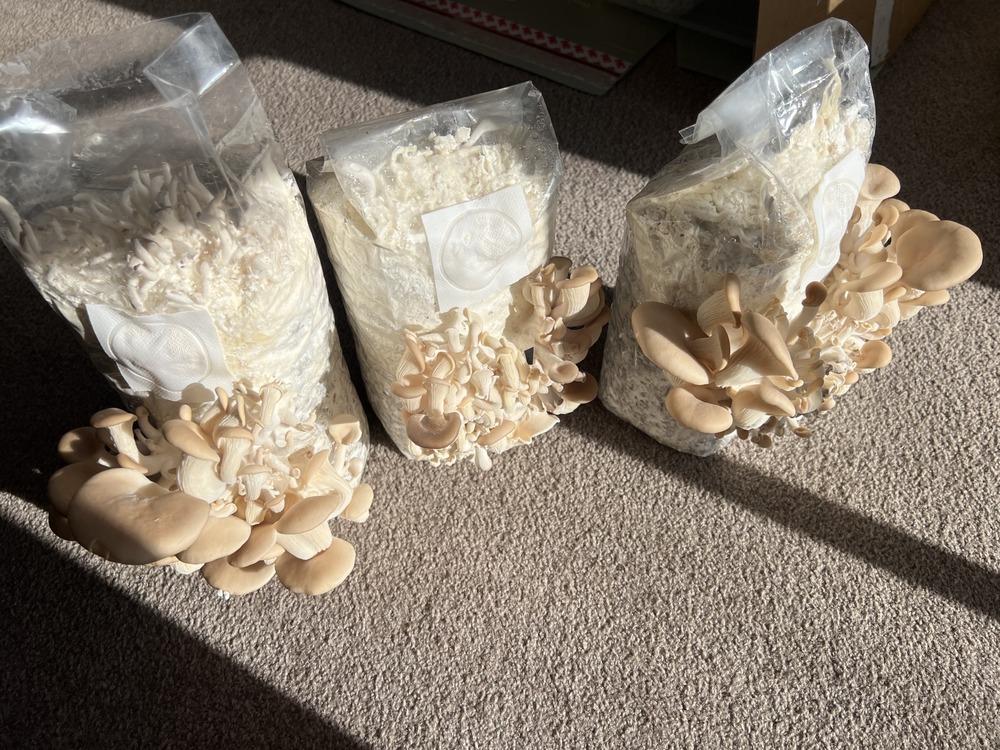Have you wanted to grow mushrooms but didn't know where to start? Here's a relatively easy and foolproof technique that doesn't require equipment or sterilization and can be done in an afternoon.
MATERIALS:
Mushroom spawn - the two types that work well for this are oyster mushrooms (any variety, although given that oyster mushrooms tend to be copious spore producers and the spores are known for causing health problems, sporeless oysters are best for indoors/small spaces) and what's known as bear'a head or lion's mane. The latter produced a shaggy ball-shaped mushroom and is enjoying a moment right now because it helps keep nerves healthy. It's also darn tasty and can be enjoyed in stir fries and sushi (if cooked!). Pioppino might also do well in this setup, but I have never tried it. Mushroom spawn can be purchased online. I like Field & Forest Products as a supplier.
Yesterday's News Kitty Litter: made from pelletized newspaper, do not substitute feline pine or other wood-based brands
Guinea Pig Chow: you want pelletized Timothy hay
Dechlorinated Water - Hot water out of the faucet that has been allowed to cool works, so does distilled or filtered water, or tap water that has been brought to a boil and allowed to cool. You need 4 cups per batch.
Newspaper Bags: any tube shaped plastic bag will do. Small mushroom grow bags are available on Amazon and also work well.
A clean plastic tub for mixing (for best results wipe out beforehand with hydrogen peroxide or a 1:10 bleach dilution)
METHOD
Making the artificial log:
Using clean or gloved hands, mix 4 cups of yesterday's news, two handfuls of guinea pig chow, and 4 cups of water until the water is fully incorporated. Add in about a cup of spawn (less works, but it is slightly riskier), breaking up the clumps with your fingers. Scoop the inoculated medium into your bag, tap on the counter a couple times to pack it down, then tie it off.
Spawn Run: Over the course of the next couple of weeks, the mushroom spawn will colonize the artificial logs, causing the medium to become cohesive and whitish in color. If you see green, powdery growth, you have trichoderma contamination and should discard. Black splotches are mold and also a sign your log is compromised.
Fruiting:
Oxygen is the trigger to switch over from vegetative growth to making mushrooms. Tiny pinheads called primordia will often form in places where there's gaps between substrate and bag; you can look for them and make small x cuts in the bag with a pair of scissors, or you can just pierce the bag in regular intervals on one side. Keeping the bag in a humid environment, placing it in a shopping bag, or misting it regularly can improve yield. Once the mushrooms are mature, you can harvest them (ideally before they drop a lot of spores). If you're growing bear's head, the tips starting to yellow is a sign that the fruiting body is done growing.
A second flush can be obtained by soaking the bags in dechlorinated water for at least a couple of hours. Expect 1-2 pounds of yield from each bag.
WHY IT WORKS
The mushrooms we're growing here are known as white rot fungi and have been evolutionary honed to tolerate wood, a growing medium that most other decomposers hate because it's low in nitrogen and high in forms of carbohydrate that are difficult to break down. White rot fungi are not really used to competitors and are happy to take their time, which means that they can spend years breaking down a log before deciding to fruit. This is disadvantageous from a less patient human cultivator's point of view.
We can speed the process up by offering tastier forms of nutrition, but that will attract faster-growing fungi who can muscle out our target species. Thus, growing mushrooms successfully without contamination requires either an environment more suited to the target mushroom than faster-growing competitors (that is, it is relatively low in nutrients), or a rigorous commitment to ensuring the competitors are kept out of the medium. We take a hybrid approach here: both the litter and the Timothy pellets are sterilized during manufacturing, so we don't have to worry as much about aseptic technique, but the resulting medium is still less nutritious than something designed for high yields, such as master's mix. Keeping the logs comparatively small and using a high spawn ratio also allows the edible mushroom to quickly complete a life cycle before any spores that have drifted in have a chance to get established, with the drawback of increasing cost per unit produced.
COST/MATERIAL CONSIDERATIONS
You're looking at roughly $80 - 100 in materials to get off the ground, with your main expense being the mushroom spawn. A 5 lb bag of spawn should be enough for 20 or so mini logs, so at $5/lb of mushrooms at the high end, you're beating the grocery store or farmer's market pretty handily. This is also a lot to make at once, and spawn does have a limited shelf life (although it can be stored in the fridge for a couple of weeks). High nutrient spawns like rye tend to get chewed through quickly and you can often find your spawn bags fruiting on their own (not necessarily the worst outcome).
If you're worried about waste and not sure where you'd keep 20 newspaper bags full of mycelium, consider splitting the cost with friends or making your own spawn in smaller batches. Spore/mycelium syringes for edible varieties are available online, and the popular and relatively reliable "Uncle Ben's tek" used for Psilocybes will also work for the more licit species of fungi. That's a post for another time, though.
OKAY I GREW SOME MUSHROOMS, NOW WHAT?
Spent logs can theoretically be used to spawn new ones, although the chances for contamination go up and yields can decline over time. They can also be composted or tossed on a log pile to see if you get some mushrooms the natural way.
Awesome guide, thanks for posting. This is terrific info. I think I’ll give this a shot and sub the hamster feed for wood stove pellets, or bbq pellets for wood loving species. I bet you could do shiitake this way. Maybe even p azurescens

This could be a fun community project or kids science experiment.
Glad you found it helpful! Pellets wouldn't be a good substitute for the timothy pellets because the goal is to drop the C:N ratio a little, and wood has a high C:N ratio. You could theoretically sub out the yesterday's news with pellets, but growth is slower. Typically you'd supplement a sawdust-type substrate like pellets with wheat bran, but that's caused me no end of contamination headaches, even when I'm careful to pasteurize. Also note that you want something labeled 100% hardwood because softwoods can mess with growth (they don't like tannins). I haven't tried shiitake using this method but would definitely be interested in seeing some results!
Can this be done with oyster spores, or do you need to get a liquid culture?
Typically you use spores to prepare a grain spawn that you then use to inoculated your medium, but you can use spores directly. They tend to work better with a low-nutrient medium like pasteurized straw to reduce the odds of contamination.
They tend to work better with a low-nutrient medium like pasteurized straw to reduce the odds of contamination.
The guinea pig pellets are basically pasteurized straw, though, right?
They're fortified so the nitrogen content is much higher (roughly 10x) compared to regular straw.
This is so cool, thanks for posting. I've suddenly got 8 bags of oyster mushrooms all fruiting!
 Show
Show


